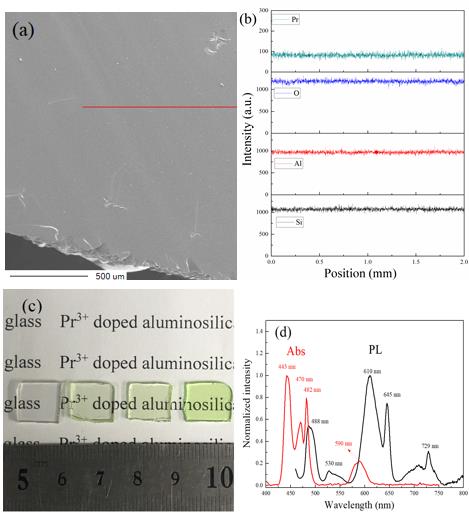Broadband emissions in the visible spectral range can be achieved by pumping Pr3+ doped in crystal, ceramic and glass. Fluoride glasses are commonly used as host material of gain fiber due to their low-energy phonon distribution. Unfortunately, poor mechanical strength, and chemical stability, challenging fabrication and expensive cost all limit their development and further application in practice.
Currently, aluminosilicate glasses are well known for their mechanical strength, chemical resistance, bio-compatibility and broad viscosity window that is key for synthesis of large-scale bulk glass and optical fibers. Therefore, further exploration of Pr3+-doped aluminosilicate glasses fibers with good performance is urgently required.
Most recently, a research team led by Shanghai Institute of Optics and Fine Mechanics, Chinese Academy of Sciences, has succeeded in broadening the absorption and emission bands by using Pr3+-doped aluminosilicate glasses. The study was published in Journal of Luminescence.
In their experiment, Pr3+-doped aluminosilicate glasses were synthesized as a function of Pr3+ ions concentration by mature processing techniques. The element distributions, phases, absorption, emissin spectra, and fluorescence lifetimes of Pr3+ ions were characterized and inverstigated. Homogeneous element distributions and uniform non-crystalline phases demonstrated a good quality of their aluminosilicate glasses.
They found that a strong absorption at visible wavelengths between 440 and 500 nm and the corresponding intense emission in the visible spectrum from 570 to 660 nm presented an excellent optical properties of Pr3+-doped aluminosilicate glasses. Also, the cross relaxation processes arising from concentration quenching effect led to an optimum Pr2O3 concentration for visible emission.
Moreover, as a long lifetime of fluorescence decay is favorable for more efficient laser operation, a longest lifetime (115 μs) of 3P0 level in Pr3+-doped aluminosilicate glasses was measured, which was much higher than those in other kind of glasses.
This research may lead to a host material for fiber laser operated at visible wavelength.
This work was supported by National Key R&D Program of China, National Natural Science Foundation of China and Natural Science Foundation of Shanghai.

Characterizations of Pr3+-doped aluminosilicate glasses. (Image by SIOM)
Article website:
https://www.sciencedirect.com/science/article/pii/S0022231319316722
Contact:
Mr. CAO Yong
General Administrative Office
Shanghai Institute of Optics and Fine Mechanics, CAS
Email: caoyong@siom.ac.cn